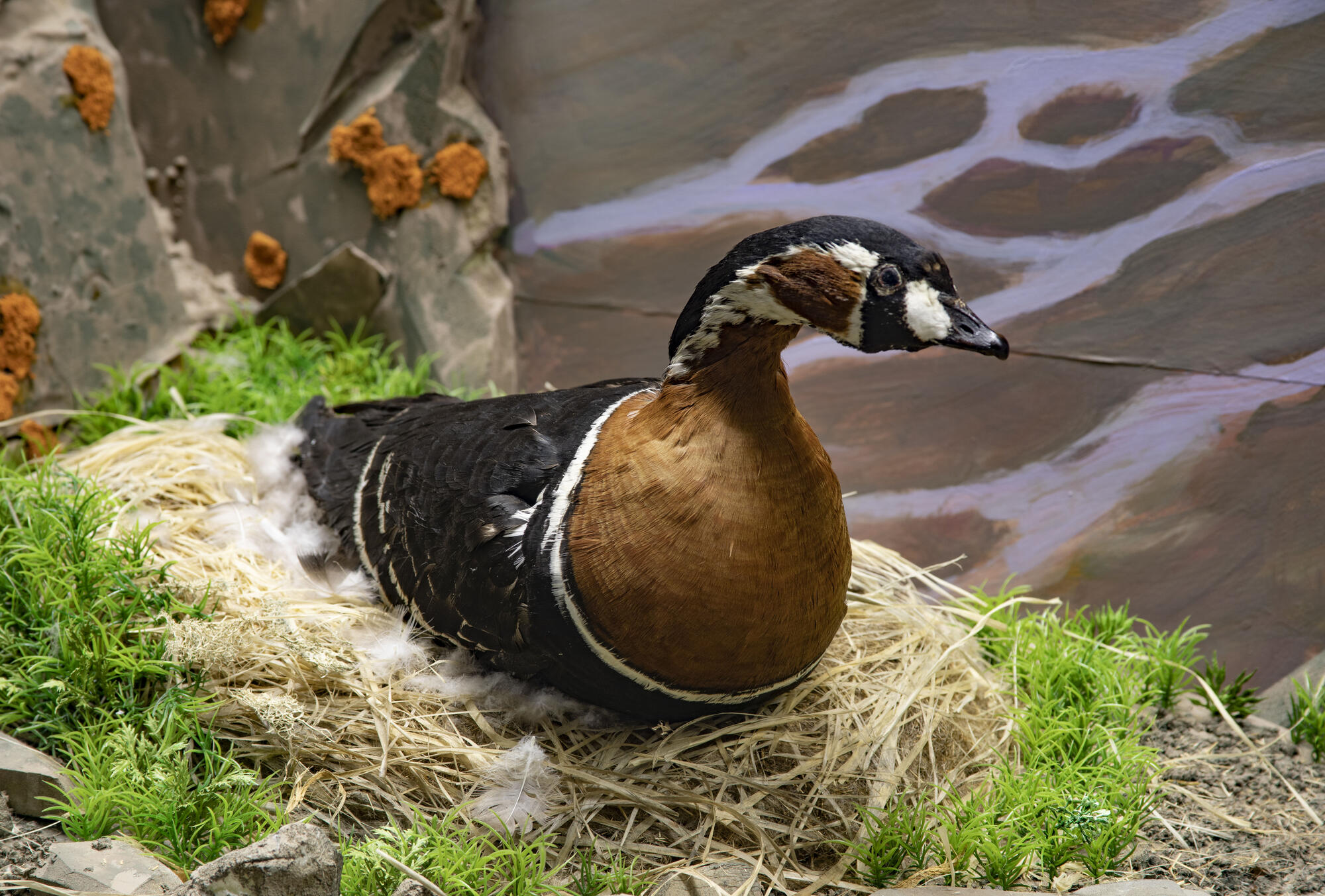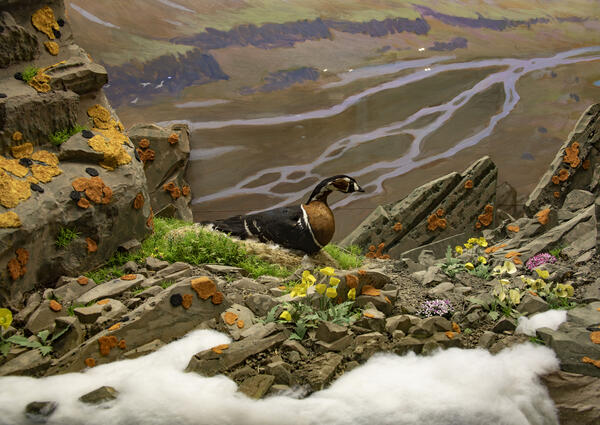The red-breasted goose is a waterfowl of the Anatidae family, the Anseriformes order. It differs from other geese species by being small (weight 1–1.7 kg, wingspan up to 135 cm) and by bright coloration; in addition, the adult bird retains “juvenile” features: a small beak, big forehead, and a short and thick due to the feathers neck; relatively short legs. Ornithologists point out their “childish” disorderly flight, lacking any strict order. For these traits in the 18th century, they were affectionately called gus’ki (little geese).
The homeland of the red-breasted goose is the Taimyr Peninsula. Their range extends from the arctic tundra to the northern belt of the forest-tundra in Western Taimyr, to the border of the arctic tundra in the north, and to the border of the forest-tundra in the south (Central Taimyr). In the Eastern Taimyr, the nesting boundary of the species runs from the mouth of the Shrenka River along the northern shore of Lake Taimyr to the Bikady River valley, then southeast to the mouth of the Gusikha and Bolshaya Balakhnya Rivers, and from there to the lower Popigai River.
Red-breasted geese make couples once for life after a beautiful courtship ceremony with songs, ritual dance, and demonstration of “fighting skills”. Laying from three to eight eggs, the female insulates the nest with down hair from her breast. Nestlings hatch out in the first half of July and fledge in mid-August. Autumn migration begins in late summer; the main routes pass through Northern Kazakhstan, the Black Sea region, and the south of Western Siberia. In winter, birds migrate to the Black Sea coast and the South Caspian Sea, and less often to the lower reaches of the Yangtze River in China. Their diet mainly consists of plant food rich in protein, such as cotton grass, cereals, and sedges.
Red-breasted goose is a vulnerable species. Their natural enemies include polar foxes, foxes, gulls, hawks, owls, and peregrine falcons. For safety reasons, they live in colonies of 4–8 to 24 couples and build their nests in rocky or earthen caves. These colonies are “controlled” by owls or peregrine falcons, which do not hunt in their own territory and keep away other predators. During the molting period, red-breasted geese are deprived of the possibility to fly, so they gather in flocks of up to hundreds of individuals.
Hunters and poachers who shot and captured red-breasted geese, especially during the molting period, migration, and wintering, caused great damage to the population. At the beginning of the 20th century, the number of birds has fallen dropped to 6,500.
Today, red-breasted geese are listed in the Red Data Book of the Russian Federation and Krasnoyarsk territory; it is forbidden to hunt them in their wintering grounds. In Krasnoyarsk territory, nesting geese are protected in the Taimyr Nature Reserve.
The homeland of the red-breasted goose is the Taimyr Peninsula. Their range extends from the arctic tundra to the northern belt of the forest-tundra in Western Taimyr, to the border of the arctic tundra in the north, and to the border of the forest-tundra in the south (Central Taimyr). In the Eastern Taimyr, the nesting boundary of the species runs from the mouth of the Shrenka River along the northern shore of Lake Taimyr to the Bikady River valley, then southeast to the mouth of the Gusikha and Bolshaya Balakhnya Rivers, and from there to the lower Popigai River.
Red-breasted geese make couples once for life after a beautiful courtship ceremony with songs, ritual dance, and demonstration of “fighting skills”. Laying from three to eight eggs, the female insulates the nest with down hair from her breast. Nestlings hatch out in the first half of July and fledge in mid-August. Autumn migration begins in late summer; the main routes pass through Northern Kazakhstan, the Black Sea region, and the south of Western Siberia. In winter, birds migrate to the Black Sea coast and the South Caspian Sea, and less often to the lower reaches of the Yangtze River in China. Their diet mainly consists of plant food rich in protein, such as cotton grass, cereals, and sedges.
Red-breasted goose is a vulnerable species. Their natural enemies include polar foxes, foxes, gulls, hawks, owls, and peregrine falcons. For safety reasons, they live in colonies of 4–8 to 24 couples and build their nests in rocky or earthen caves. These colonies are “controlled” by owls or peregrine falcons, which do not hunt in their own territory and keep away other predators. During the molting period, red-breasted geese are deprived of the possibility to fly, so they gather in flocks of up to hundreds of individuals.
Hunters and poachers who shot and captured red-breasted geese, especially during the molting period, migration, and wintering, caused great damage to the population. At the beginning of the 20th century, the number of birds has fallen dropped to 6,500.
Today, red-breasted geese are listed in the Red Data Book of the Russian Federation and Krasnoyarsk territory; it is forbidden to hunt them in their wintering grounds. In Krasnoyarsk territory, nesting geese are protected in the Taimyr Nature Reserve.




